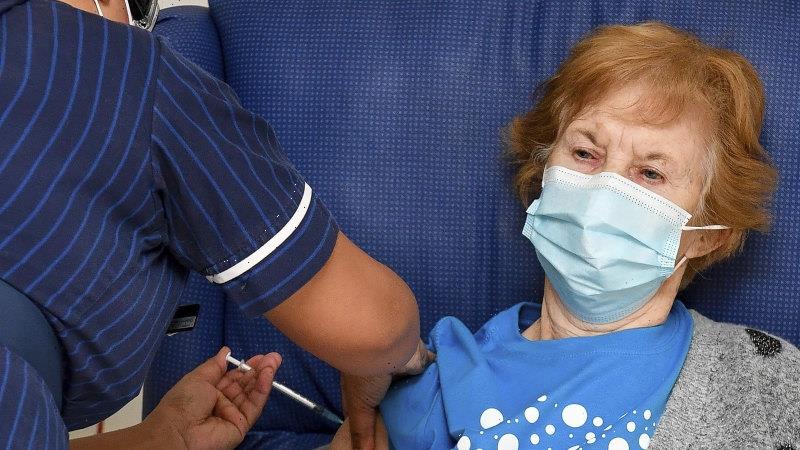London: Next week will mark three years since the day when Margaret Keenan donned a bright blue, short-sleeved t-shirt with a penguin on the front and the words Merry Christmas.
The 91-year-old British woman made history wearing that almost childlike t-shirt that day, when she became the first known person to receive a vaccination for COVID-19, the virus that had emerged from Wuhan, China earlier that year that went on to kill millions and choke economies, as governments ordered their people into lockdown.
Margaret Keenan, 90, was the first patient in Britain to receive the Pfizer-BioNTech COVID-19 vaccine under the government’s rollout.Credit:AP
The bright colours of her t-shirt were symbolic of what was around the corner – hope.
Hope that decades of investment into scientific research were about to pay off and save the world from the huge daily death tolls, which were blighting the year of 2020 and causing crippling border closures around the world.
Now Keenan’s shirt, the vial that contained her life-saving dose and the syringe used to inject into her arm have gone on display at Britain’s Science Museum in south-west London.
The Merry Christmas t-shirt worn by British woman Margaret Keenan who was the first person to receive a COVID-19 vaccine on display at Britain’s Science Museum in London.Credit:Latika Bourke
The exhibition Injecting Hope: the race for a COVID-19 vaccine tracks the remarkable success in the world’s ability to produce multiple vaccines within around 12 months of the pandemic being declared.
Stewart Emmens, lead curator of the exhibition, said he began collecting around 1000 objects since early 2020, well before the first vaccines were announced.
“COVID-19 impacted on all of us but from the moment it appeared it triggered a science-led response which, fortunately for us, scientists were able to call upon an amazing amount of research and existing knowledge and redirect it to produce effective vaccines in less than a year,” he told The Sydney Morning Herald and The Age.
“And even though it’s only less than two years ago since that first vaccination in this country with Margaret Keenan, COVID-19 is still very much part of our lives, in many ways vaccines have become almost routine in our lives.
“And if you look back, two years ago to what had been achieved, it’s a really incredible story, everything happened quickly and largely very efficiently to produce this incredible outcome in such a short time.”
Professor Sarah Gilbert’s mug.Credit:Latika Bourke
Please insert photo of Gilbert’s mug here
The Science museum’s own role in hosting one of London’s largest vaccination centres during the pandemic, administering 139,000 jabs, is documented in the exhibition, which also includes the Keep Calm and Make Vaccines mug which sat on Dame Professor Sarah Gilbert’s desk as she created the Oxford/AstraZeneca vaccine, the chair on which the first person to receive trial dose sat, as well as sculptural representations of the virus itself.
A notebook with handwritten notes by the woman who oversaw the UK’s vaccine rollout, Kate Bingham, setting out the early stages of the enormous project is on display.
“I quite like objects that in other contexts are quite ordinary but because of their association are very special,” Emmens said.
This photograph of scientists working at CSL’s Broadmeadows factory is featured in a new exhibition at Britain’s Science Museum in London about the race to unlock a COVID-19 vaccine.Credit:Chris Hopkins
He says he was invited by the NHS to visit their headquarters’ a year ago to take whatever he wanted to keep for records relating to the vaccine rollout.
“They said ‘just help yourself,’” he recalled. “I’m sure it would have gone in the bin otherwise.”
Also prominent is a huge reproduction of an image inside CSL’s Broadmeadows factory taken by this masthead’s photojournalist Chris Hopkins showcasing the enormous scale in production of the vaccines that was taken around the world.
But while the focus of the exhibition is on the creation of the vaccines, it does allude to the vaccine nationalism, inequities in distribution as rich countries bought up supplies first and the preferences exhibited in some countries for Pfizer’s vaccine, because of rare blood-clotting cases in some people who were given the Oxford vaccine which AstraZeneca originally supplied at cost.
“We’re very clear that the distribution has been unequal,” Emmens said.
“It’s a not a black and white story, we’re mainly looking at the challenges of creating it, trialling it and mass-manufacturing and rollout, within that we certainly suggest there’s a lot of other things going on.”
“It wasn’t a smooth story,” he said.
Get a note directly from our foreign correspondents on what’s making headlines around the world. Sign up for the weekly What in the World newsletter here.
Most Viewed in World
From our partners
Source: Read Full Article




